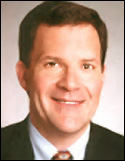At its first major teleconference with the press, EPCglobal, the nonprofit organization created by the Uniform Code Council and EAN International to commercialize Electronic Product Code (EPC) technology, announced that it expects its Class 1 Gen 2 standard to be complete by autumn. The group has also announced it will extend its IP agreement to retailers and consumer goods manufacturers taking part in the development of its next-generation standard.
Hosting the call from the EPCglobal Summit in Orlando, Fla., where 350 representatives from 168 ECPglobal member companies from around the world had gathered, EPCglobal executives outlined the group’s progress since taking responsibility for EPC development from the Auto-ID Center six months ago. According to EPCglobal, any fears prior to that handover that the support and momentum developed by the Auto-ID Center would be lost have proven to be unfounded. “The exact opposite has been true. Momentum has done nothing but build over the past six months,” said Mike Di Yeso, president and COO of the Uniform Code Council.
The group set out a rough timetable for its highly anticipated second-generation EPC air interface standard—formerly known as Class 1 Generation 2 or Class 1 Gen 2—which EPCglobal has renamed the UHF Generation 2 Foundation Protocol. The new standard should enable faster and more reliable read rates for EPCglobal tags while also increasing read ranges and provide better capabilities to link to a standard global network system.
According to Sue Hutchinson, technical expert for EPCglobal US, the group expects to publish a working draft for its next-generation EPC tag design during the summer this year. The organization expects its members will ratify the standard a few months later, in fall 2004. “It is important to build quickly and to build robustness into the specification,” said Hutchinson. That robustness will ensure that the technology is reliable and accurate for worldwide deployment and will come from the ongoing work within the EPCglobal working action groups.
The UHF Generation 2 Foundation Protocol will also form the basis for EPCglobal’s plans to have its work incorporated into an ISO standard. “When Generation 2 has been approved, we will take it through the ISO process to get the buy-in from ISO-committed companies,” said Bernie Hogan, the CTO of the Uniform Code Council.
The group also said that it is making significant progress on winning support for its intellectual property agreement among its members that make and sell RFID-related hardware and software. That agreement basically ensures that intellectual property created before a company joined EPCglobal is protected and that if a company’s IP is needed for a standards specification, the company can decide whether or not to contribute it.
So far, of EPCglobal’s 200 member companies, 129 members—all vendors of RFID-related hardware or software have agreed to the EPCglobal IP policy, and others could be announced “within days,” according to Dicki Lulay, president, EPCglobal US. The group says that it will shortly ask its user members such as Wal-Mart or Gillette to sign the IP agreement as well. Although users do not typically own RFID-related IP, EPCglobal’s user action group will be working to resolve specific EPC implementation issues, which may result in the creation of some IP.
The group also announced the names of the two major companies that most recently joined the EPCglobal Board of governors. Those companies are CPG giant Johnson & Johnson, which will head the group’s healthcare board and IT systems giant Hewlett-Packard, which will head the group’s high-tech group.
The EPCglobal Summit, which ran from March 16 to 18, was billed as a state-of-the-business conference as well a place for Technical Action Group meetings for EPCglobal subscribers.


